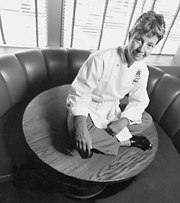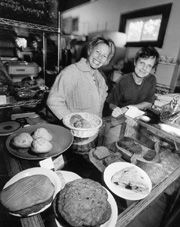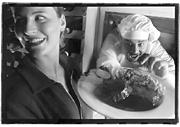Perpetually vexing to restaurant critics is the matter of whether to judge a restaurant by one’s own standards of quality or by the establishment’s standards for itself. “Does the place please me?” and “Does it succeed at what it’s trying to do?” are frequently two different questions. The best greasy spoon in the world is still, after all, a greasy spoon.
Cutters Bayhouse
2001 Western, 448-4884 dinner daily; lunch Mon-Sat; brunch Sun full bar major credit cards; local checks
And Cutters Bayhouse, Restaurants Unlimited’s sprawling institution at the north end of Pike Place Market, will always be Cutters Bayhouse. When the place opened its doors in 1983, culinary clichés like grazing and open kitchens and heart-healthy menu items were startling innovations. Yuppies and tourists teemed in the gleaming bar and windowy rooms. Like some restaurants will—nothing says 1950s like Canlis, or 1990s like the Dahlia Lounge—Cutters became an icon of its decade, lodged in a dubious ’80s time warp with Miami Vice and Cats, big hair, and wine coolers.
So when word came down of a thoroughgoing remodel, we wondered if Cutters had grown into the ’90s. The place is now awash in reds and coppers, punctuated throughout with whimsical blown-glass light fixtures; the carpet is vermilion plaid. The kitchen is now concealed. These were big-bucks improvements, and they’re all very designed, very restauranty. But to this visitor they hardly registered as different, altogether trumped as they are by the overwhelming impressions Cutters has always left: vastness, vitality, and that sweeping grandstand view.
Likewise the menu, though heavily inflected with the Asian fusion accent so trendy in recent years, still reads the same as it ever did: a section of “Small Plates,” a section of “Shared Plates,” a section of “Starter Plates,” some fish. (Think of a florid novella with too many chapters, too many descriptors, and no evidence of an editor—that’s Cutters’ menu.) Off the “Starter” list we chose a raspberry vinaigrette salad ($4.95) with wild greens, slivered almonds, big, sugary shards of Walla Walla sweet, and beautiful berries—a lush, if too amply dressed, melange of sweet and savory. Off the “Small Plates” list we sampled the seafood brochette ($12.95), in which applewood-grilled halibut, salmon, and prawns came served over glass noodles tossed with feta and red onions and topped with basil pesto. Whew: too many words, too many elements, too too much much. Though the fish was perfectly cooked, this dish tasted unedited.
The simpler, we discovered, the better. A flawlessly grilled piece of salmon ($20.95), though teamed with a mushy side of potatoes, suggested an admirable exactitude with seafood. My wok-fired sake-soy-glazed yakisoba ($16.95), on the other hand, featured overcooked prawns amid the soba noodles and julienned vegetables and pickled ginger. Slogging through this towering tangle of noodles felt like the overland route across Siberia—never-ending sameness.
Cutters’ food, we concluded, just isn’t very interesting. We came back for brunch and tried the four-egg Northwest seafood omelette ($10.95)—Dungeness crab, shrimp, mushrooms, mozzarella—which was bland in a more forgivable breakfast-food kind of way, but still bland. The exception to prove the rule was a marvelous pecan-raisin French toast ($9.95), soaked in Grand Marnier batter and served alongside apple compote to spoon on top. We could taste the intelligence behind this conception—the sprightly apple zing breaking the rich intensity of the caramely toast—and we knew: Here’s what Cutters is capable of.
But what our visits revealed above all was the fact that Cutters couldn’t care less what I think of it. The place isn’t trying to please local foodies with culinary greatness; it doesn’t have to. As our seater engaged us with friendly banter on the way to our table, explaining about the parent corporation’s other properties and where they were around Seattle, it dawned on me that she assumed we were visitors from some place else. Not a bad default assumption, in a restaurant for whom so much business pours down the hill from the hotel district.
The fact is—and I mean this in the nicest possible way—Cutters isn’t committed to food. It’s committed to tourists. Once you understand that this is its standard, you realize that Cutters is a roaring, crashing success. Its cavernous size assures that there’s almost always a table for the drop-in sightseer. Its culinary strong point—knowing precisely when to take a piece of fish off the grill—plays right to the out-of-towner’s prime culinary interest in Seattle. Even the annoying loquacity of the menu (“The largest of all crab, the King may weigh up to 20 pounds . . . “) makes sense given that this customer base is, in fact, interested.
Admirably, Cutters even exceeds the tourist-restaurant standard in one area. Tourist restaurants with great views don’t need to offer great service; they’re not in it for the repeat visit, but the one-time gouge. In both of our meals, Cutters service was first-rate: intelligent, intuitive, easygoing, and willing to go the extra mile. Cutters may not have terrific food, but I could name a dozen terrific restaurants that should make a study of its staff.







